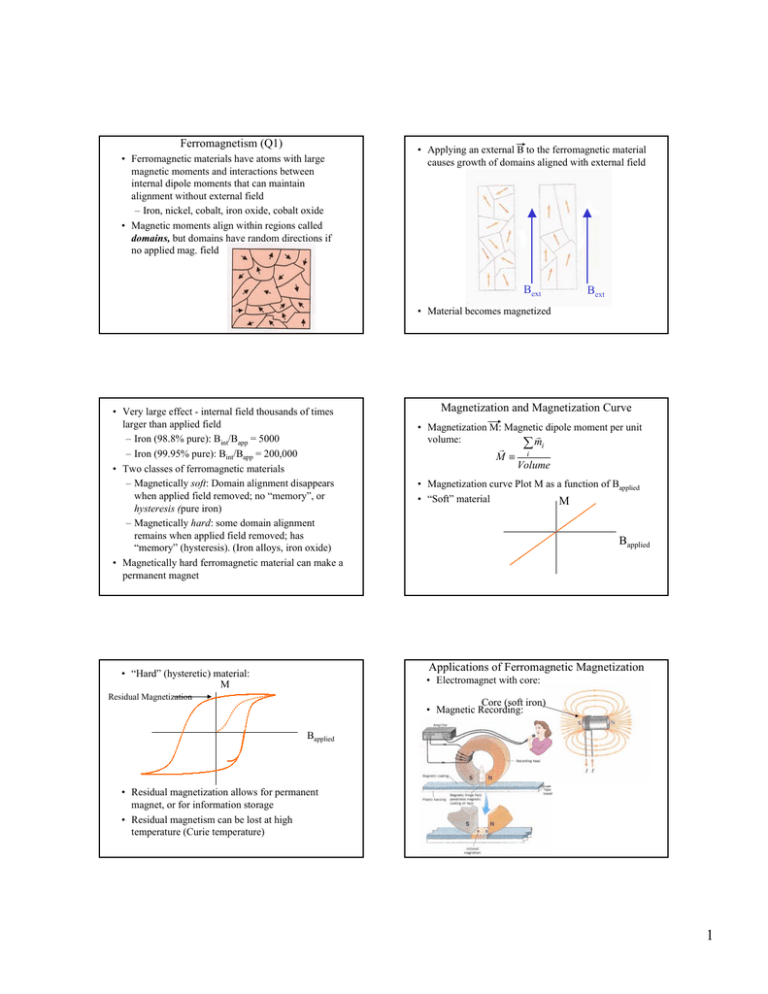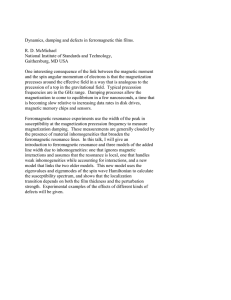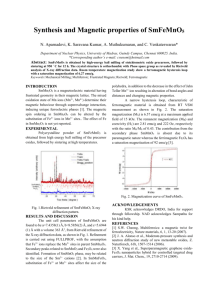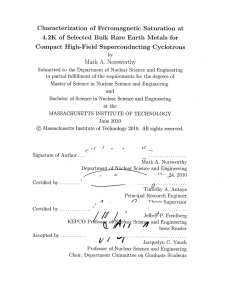Ferromagnetism (Q1)
advertisement

Ferromagnetism (Q1) • Ferromagnetic materials have atoms with large magnetic moments and interactions between internal dipole moments that can maintain alignment without external field – Iron, nickel, cobalt, iron oxide, cobalt oxide • Magnetic moments align within regions called domains, but domains have random directions if no applied mag. field • Applying an external B to the ferromagnetic material causes growth of domains aligned with external field Bext Bext • Material becomes magnetized • Very large effect - internal field thousands of times larger than applied field – Iron (98.8% pure): Bint/Bapp = 5000 – Iron (99.95% pure): Bint/Bapp = 200,000 • Two classes of ferromagnetic materials – Magnetically soft: Domain alignment disappears when applied field removed; no “memory”, or hysteresis (pure iron) – Magnetically hard: some domain alignment remains when applied field removed; has “memory” (hysteresis). (Iron alloys, iron oxide) • Magnetically hard ferromagnetic material can make a permanent magnet Magnetization and Magnetization Curve • Magnetization M: Magnetic dipole moment per unit r volume: ∑m r M≡ i i Volume • Magnetization curve Plot M as a function of Bapplied • “Soft” material M Bapplied Applications of Ferromagnetic Magnetization • “Hard” (hysteretic) material: M • Electromagnet with core: Residual Magnetization Core (soft iron) • Magnetic Recording: Bapplied • Residual magnetization allows for permanent magnet, or for information storage • Residual magnetism can be lost at high temperature (Curie temperature) 1 Magnetic Data Storage • “Hard: drive: • “Floppy” Disk: – Magnetic Specifications. Sony MFD-2HD: Residual Magnetic Flux Density: 75 mT Squareness: 0.7 • Videotape, credit cards, ... Permanent Magnets • Ferromagnetic material with residual magnetization • Lines of B emerge from “North pole” of magnet and return into “South pole.” Magnetic Field Intensity H and Susceptibility • As with charges, like poles repel, unlike poles attract (but never find isolated magnetic poles; only dipoles) • Magnetic Field Intensity H is basically the “applied” magnetic field r divided by µ0: • Magnetic compass is a permanent magnet on a pivot • Unit of H: A/m • For most materials, the magnetization M is related to H by the magnetic susceptibility χm: r B r H≡ −M µ0 r r M = χmH • Magnetic susceptibility (dimensionless) is positive for paramagnetic materials, negative for diamagnetic. It is usually <<1 (see text Table 29.2), but is large for ferromagnetic materials. It has a complicated temperature dependence. (Q2) 2





